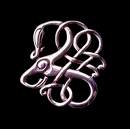 I know very little about "Viking Art". I came across photos of the Urnes Stave Chruch today - a "World Heritage Site". I think the style of wood carving is awesome.
I know very little about "Viking Art". I came across photos of the Urnes Stave Chruch today - a "World Heritage Site". I think the style of wood carving is awesome.  This reminds me of "Art Nouveau" - the art movement popular around 1900 ("Art Nouveau was characterized by writhing plant forms"...). Art Nouveau was supposedly "new" and different. The Urnes style metal piece here would be quite at home in an Art Nouveau collection. The Urnes style seems to be the parent (or great-grandparent) of that style. So it seems that Art Nouveau is not new at all (but very few art styles are).
This reminds me of "Art Nouveau" - the art movement popular around 1900 ("Art Nouveau was characterized by writhing plant forms"...). Art Nouveau was supposedly "new" and different. The Urnes style metal piece here would be quite at home in an Art Nouveau collection. The Urnes style seems to be the parent (or great-grandparent) of that style. So it seems that Art Nouveau is not new at all (but very few art styles are).From a site on Viking Art:
Urnes 1040 - 1150 AD - The last and most widely spread of the ornamentation styles.
Wood-carvings on a stave church in Urnes, Norway, has given the name for this style.
Motifs:
The animals are curvaceous, often including one or more snakes.
The spiral hip is still used but not as big and pronounced as in earlier styles.
The animals often bites each other.
Big almond shaped eyes.
A true Scandinavian style with few influences from abroad.
This style is also called rune-stone style because it is used mainly on rune stones in Sweden. It is a style that has been perfected for carving in stone or wood though it is based on long curves without to many details. The style was widely spread in the Viking World and can easily be said to be the most popular af all Viking ornamentation styles.
________________________
I wonder if Urnes Stave Church had anything to do with Urnenfelder (meaning urnfield carriers) which were a people who utilized cremation as opposed to inhumation (interment of dead). I came across this about "Urnenfelders" when I was looking into things, today:
A new vision of life had arisen; its centre was Lausitz, a land between Germany and Poland. Worship of forces of nature gradually evolved towards certain forms of monotheism and generated the faith in afterlife and a profound respect of dead....
Ancient historians identified these peoples by the name Veneti, referring to them as the people who conquered peacefully half of Europe, not by force but by means of their shining spiritual energy...
We know of the ancient Veneti's social structure that it was based on village (or town) community and that woman's position was equal to male -- unlike a typical patriarchate of other Indo-Europeans. As it is usually the case, the best records of a civilization are left to us by the remains of burials and same is true for Veneti...
The primigenial religion of the ancient Veneti preserved this sense of harmony among the Universe's elements, likewise the oriental religions.
No comments:
Post a Comment